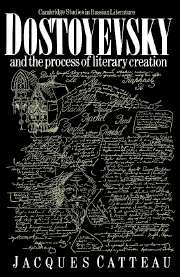Book contents
- Frontmatter
- Contents
- Preface to the English edition
- List of abbreviations
- General editor's note on transliteration and references
- General introduction
- PART I The creative environment
- PART II The process of creation
- Part III Time and space in the world of the novels
- Introduction
- 19 The master of men and hours
- 20 Chronology and temporality in The Idiot
- 21 The ascending spiral
- 22 Time of power and power of time
- 23 The havens of eternity
- 24 The dream of space and the space of the real
- 25 The inventory and the expressionist orchestration of scenery and lighting
- 26 The semantics of colour
- 27 The hero in space: sighting and seeing
- Conclusion
- Notes
- Select bibliography
- Index of names
25 - The inventory and the expressionist orchestration of scenery and lighting
Published online by Cambridge University Press: 18 December 2009
- Frontmatter
- Contents
- Preface to the English edition
- List of abbreviations
- General editor's note on transliteration and references
- General introduction
- PART I The creative environment
- PART II The process of creation
- Part III Time and space in the world of the novels
- Introduction
- 19 The master of men and hours
- 20 Chronology and temporality in The Idiot
- 21 The ascending spiral
- 22 Time of power and power of time
- 23 The havens of eternity
- 24 The dream of space and the space of the real
- 25 The inventory and the expressionist orchestration of scenery and lighting
- 26 The semantics of colour
- 27 The hero in space: sighting and seeing
- Conclusion
- Notes
- Select bibliography
- Index of names
Summary
With delicacy of feeling and mind an artist can make a great deal of effect simply by the way he arranges the parts played by those objects of poverty, the domestic utensils of a poor hovel, and by this amusing arrangement he can impress the heart.
F. M. Dostoyevsky, Diary of a Writer, 1877Inventory of the scenery
Dostoyevsky constructs a scene by enumerating objects, by arranging volumes, and measuring places. Both as props man and as architect and decorator, he limits himself to defining a space in which human beings evolve, choosing only what is strictly necessary for the action and the idea. This is not inevitably sober: occasionally there is a rich abundance of objects, as in a Dutch picture, to convey an idea of profusion. Dostoyevsky does not give descriptions (ppisaniyd) but inventories (opisi).
Here, for example, is the surprising ‘description’ of Ikhmenev's garden in The Insulted and Injured:
This little garden belonged to the house: it was about twenty-five paces long and as many paces wide and was all overgrown with greenery. In it were three tall, old, widely branching trees, some young birch-trees, a few bushes of lilac and honeysuckle, there was a little corner for raspberries, two strawberry beds and two narrow winding paths, along and across the garden. The old man was delighted with it and swore that mushrooms would soon be growing there. But the main thing was that Nelli fell in love with this little garden.
The paces define the people who are moving in the garden and the botanical precision is a preparation for the passage where Nelli, the dying child, remembers her love for flowers.
- Type
- Chapter
- Information
- Dostoyevsky and the Process of Literary Creation , pp. 387 - 398Publisher: Cambridge University PressPrint publication year: 1989



